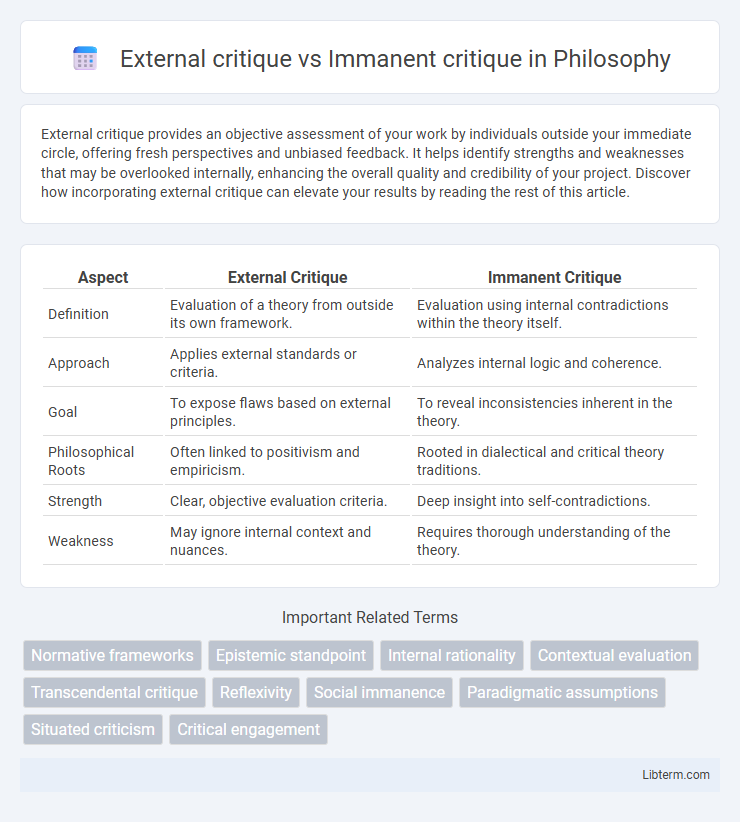External critique provides an objective assessment of your work by individuals outside your immediate circle, offering fresh perspectives and unbiased feedback. It helps identify strengths and weaknesses that may be overlooked internally, enhancing the overall quality and credibility of your project. Discover how incorporating external critique can elevate your results by reading the rest of this article.
Table of Comparison
| Aspect | External Critique | Immanent Critique |
|---|---|---|
| Definition | Evaluation of a theory from outside its own framework. | Evaluation using internal contradictions within the theory itself. |
| Approach | Applies external standards or criteria. | Analyzes internal logic and coherence. |
| Goal | To expose flaws based on external principles. | To reveal inconsistencies inherent in the theory. |
| Philosophical Roots | Often linked to positivism and empiricism. | Rooted in dialectical and critical theory traditions. |
| Strength | Clear, objective evaluation criteria. | Deep insight into self-contradictions. |
| Weakness | May ignore internal context and nuances. | Requires thorough understanding of the theory. |
Introduction to Critique in Philosophy
External critique examines philosophical ideas by comparing them to outside standards or frameworks, highlighting contradictions or limitations based on external criteria. Immanent critique operates from within a philosophical system, identifying internal inconsistencies and tensions through close analysis of its own concepts and principles. Both approaches reveal different dimensions of philosophical critique: external critique challenges from outside perspectives, while immanent critique probes the coherence and development of ideas from within.
Defining External Critique
External critique refers to the evaluation of a theory or system using standards, values, or criteria that originate outside the system itself, allowing for an objective assessment free from internal biases. It contrasts with immanent critique, which analyzes contradictions and inconsistencies inherent within the system by using its own principles as benchmarks. Applying external critique enables the identification of limitations and distortions that may remain obscured when only internal logic is considered.
Understanding Immanent Critique
Immanent critique involves analyzing a concept or system from within its own framework, identifying contradictions and inconsistencies based on its internal logic and principles. Unlike external critique, which applies outside standards or perspectives, immanent critique seeks to reveal latent tensions inherent in the object of study, fostering deeper insight and potential transformation. This method is essential in disciplines like philosophy and critical theory, where understanding the subject on its own terms enables more nuanced and constructive evaluations.
Key Differences Between External and Immanent Critique
External critique evaluates a theory or system from an outside perspective, often applying external standards or frameworks, whereas immanent critique analyzes contradictions and inconsistencies within the theory itself. External critique relies on comparative evaluation, while immanent critique seeks internal resolution and self-transformation by exposing tensions inherent to the system. The key difference lies in external critique's dependence on outside criteria versus immanent critique's focus on uncovering self-contained dialectical conflicts.
Historical Origins and Development
External critique emerges from perspectives outside the subject's theoretical framework, drawing from different ideological or disciplinary backgrounds to challenge its assumptions and validity. Immanent critique originates from within the subject's own conceptual system, analyzing internal contradictions and inconsistencies based on its principles and logic. Historically, external critique developed prominently in Enlightenment thought through cross-disciplinary challenges, while immanent critique gained traction in Hegelian dialectics and Marxist theory, emphasizing self-reflection and internal development.
Strengths of External Critique
External critique offers a clear advantage by providing an objective standpoint outside the system or theory under analysis, enabling evaluators to identify inconsistencies, biases, or limitations visible only from a different framework. This approach facilitates comprehensive cross-comparisons with alternative theories or external criteria, enhancing the rigor and relevance of the critique. Furthermore, external critique often yields transformative insights that drive systemic improvements by challenging foundational assumptions inaccessible through immanent critique alone.
Strengths of Immanent Critique
Immanent critique excels by analyzing a system's internal contradictions, allowing for a nuanced understanding that respects the context of the subject while identifying areas for improvement. This method ensures a more precise diagnosis of flaws by engaging directly with the principles and values inherent in the system itself, rather than imposing external standards. Consequently, immanent critique fosters more effective and relevant transformation within social theories, cultural practices, and ideological frameworks.
Limitations and Challenges of Each Approach
External critique often faces limitations due to its reliance on perspectives outside the system being analyzed, which can lead to misunderstandings or misinterpretations of internal dynamics. Immanent critique, while offering deep insights by assessing contradictions within the system itself, struggles with the challenge of potential bias and difficulty in maintaining objectivity. Both approaches encounter challenges in balancing comprehensive analysis with the risk of oversimplification or ideological partiality.
Practical Applications in Contemporary Discourse
External critique analyzes ideas from outside their original context, enabling the identification of inconsistencies and contradictions through comparative frameworks, which is particularly useful in legal reviews and policy evaluations. Immanent critique, rooted in the internal logic and principles of a discourse, examines concepts based on their own standards, promoting self-reflective improvements in fields such as philosophy, social theory, and cultural studies. Practical applications in contemporary discourse leverage external critique to challenge systems and institutions, while immanent critique facilitates transformative change by engaging with the inherent values and assumptions within the targeted discourse.
Choosing the Right Approach: Factors to Consider
Choosing between external critique and immanent critique involves evaluating the specific goals and context of the analysis; external critique applies standards from outside the system, useful for uncovering fundamental contradictions, while immanent critique operates within the system's own principles to reveal inconsistencies. Factors such as the target's openness to change, the critique's purpose--whether transformative or explanatory--and the nature of the system's internal logic are crucial for determining the appropriate approach. Considering these elements ensures a more effective, context-sensitive critique strategy.
External critique Infographic

 libterm.com
libterm.com